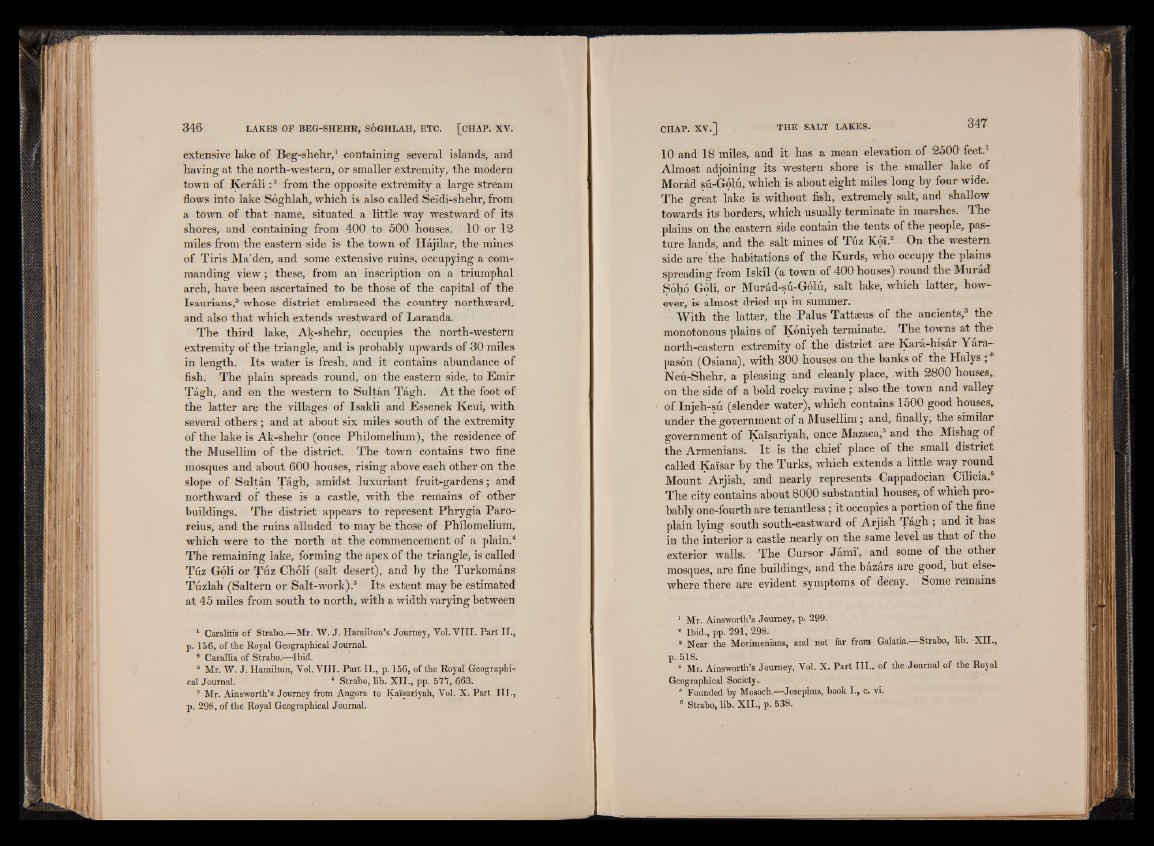
extensive lake of Beg-shehr,1 containing several islands, and
having at the north-western, or smaller extremity, the modern
town of Kerali:2 from the opposite extremity a large stream
flows into lake Soghlah, which is also called Seidi-shehr, from
a town of that name, situated a little way westward of its
shores, and containing from 400 to 500 houses. 10 or 12
miles from the eastern side is the town of Hajilar, the mines
of Tiris Ma’den, and some extensive ruins, occupying a commanding
view; these, from an inscription on a triumphal
arch, have been ascertained to be those of the capital of the
Isaurians,3 whose district embraced the country northward,
and also that which extends westward of Laranda.
The third lake, Ak-shehr, occupies the north-western
extremity of the triangle, and is probably upwards of 30 miles
in length. Its water is fresh, and it contains abundance of
fish. The plain spreads round, on the eastern side, to Emir
Tagh, and on the western to Sultan Tagh. At the foot of
the latter are the villages of Isakli and Essenek Keui, with
several others; and at about six miles south of the extremity
of the lake is Ak-shehr (once Philomelium), the residence of
the Musellim of the district. The town contains two fine
mosques and about 600 houses, rising above each other on the
slope of Sultan Tagh, amidst luxuriant fruit-gardens; and
northward of these is a castle, with the remains of other
buildings. The district appears to represent Phrygia Paro-
reius, and the ruins alluded to may be those of Philomelium,
which were to the north at the commencement of a plain.4
The remaining lake, forming the apex of the triangle, is called
Tuz Goli or Tuz Choli (salt desert), and by the Turkomans
Tuzlah (Saltern or Salt-work).5 Its extent may be estimated
at 45 miles from south to north, with a width varying between
1 Caralitis of Strabo.—Mr. W. J. Hamilton’s Journey, Vol. V III. Part II.,
p. 156, of the Royal Geographical Journal.
3 Carallia of Straho.—Ibid.
3 Mr. W. J. Hamilton, Vol. V III. Part II., p. 156, of the Royal Geographical
Journal. * Straho, lib. X II., pp. 511, 663.
5 Mr. Ainsworth’s Journey from Angora to Kai'sariyah, Vol. X. Part II I.,
p. 298, of the Royal Geographical Journal.
10 and 18 miles, and it has a mean elevation of 2500 feet.1
Almost adjoining its western shore is the smaller lake of
Morad su-Golu, which is about eight miles long by four wide.
The great lake is without fish, extremely salt, and shallow
towards its borders, which usually terminate in marshes. The
plains on the eastern side contain the tents of the people, pasture
lands, and the salt mines of Tuz Koi.a On the western
side are the habitations of the Kurds, who occupy the plains
spreading from Iskil (a town of 400 houses) round the Murad
Soho Goli, or Murad-su-Golu, salt lake, which latter, however,
is almost dried up in summer.
With the latter, the Palus Tattaeus of the ancients,3 the
monotonous plains of Koniyeh terminate. The towns at the
north-eastern extremity of the district are Kara-hisar Yara—
pason (Osiana), with 300 houses on the banks of the Halys ;*
Neu-Shehr, a pleasing and cleanly place, with 2800 houses,
on the side of a bold rocky ravine ; also the town and valley
of Injeh-su (slender water), which contains 1500 good houses,
under the government of a Musellim j and, finally, the similar
government of Kaisariyah, once Mazaca,5 and the Mishag of
the Armenians. It is the chief place of the small district
called Ka'isar by the Turks, which extends a little way round
Mount Arjish, and nearly represents Cappadocian Cilicia.6
The city contains about 8000 substantial houses, of which probably
one-fourth are tenantless; it occupies a portion of the fine
plain lying south south-eastward of Arjish Tagh ; and it has
in the interior a castle nearly on the same level as that of the
exterior walls. The Cursor J ami, and some of the other
mosques, are fine buildings, and the bazars are good, but elsewhere
there are evident symptoms of decay. Some remains
1 Mr. Ainsworth’s Journey, p. 299.
3 Ibid., pp. 291, 298.
8 Near the Morimenians, and not far from Galatia. Strabo, lib. XII.,
p. 518.
4 Mr. Ainsworth’s Journey, Vol. X. Part III., of the Journal of the Royal
Geographical Society.
8 Founded by Mosoch.—Josephus, hook I., c. vi.
3 Straho, lib. XII., p. 538.